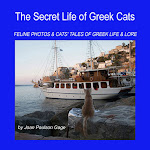I love it when one of the antique photographs in my collection
poses a mystery that sets me off on research in an effort to solve it. Often the solution remains
frustratingly elusive, as in “Is This a Lost Portrait of Lord Byron?” which has brought me fascinating e-mails
from Byron experts around the world, but has never identified the painting of
Byron that was photographed in that early ambrotype. I’m still convinced
that my ambro records an important unknown oil painting of Byron that will show up some day in a musty
English stately home.
The photograph at the top, of a charming family with five children, has had me puzzled for many years.
I call it “Mom with Messy Hair.”
It’s a large (half plate) ambrotype, which is the photographic process
that emerged during the 1850’s, after the daguerreotype. An ambrotype is a negative image on the back of a glass plate, which becomes
a positive image when you put a dark background behind it.
I was fascinated by this very attractive family because, in
an era when women never let their hair down in public, but always had it
severely pulled back and up, how can we explain this mother’s hairdo which
seems to have been “combed” with an egg beater? (To see examples of 19th century women's severe hair
styles, check out my post “Diane Arbus and Spooky Twins”).
With my usual penchant for tragedy and drama, I imagined
that perhaps this woman was an invalid—at death’s door—and the photographer had
been called in to record her image with her family before she passed away. But this mom looks perfectly happy and
well, except for what’s on top of her head.
There was also the question of the towel or piece of cloth
that has fallen on the floor at her feet. Is there a towel on the floor because
this is a sickroom? I once developed a theory, because so many people in early
daquerreotypes and ambrotypes were clutching a white handkerchief, that these
were symbols of mourning and loss, like the black arm bands and woven hair
bracelets often worn in the
1800's.
Turns out I was completely off base with that theory. More savvy collectors told me that
those white cloths and handkerchiefs were in the photo to help the photographer
focus, so that he wouldn’t get solarization—a white glare or aura around
something like a white shirt front that often mars early photos, due to the
bright sunlight’s reflection. (Remember there was no electricity back then, so
the photographer could only work on sunny days.)
After years of puzzling about the woman’s hair, I recently
posed my question to a fellow collector and member of the Daguerreian Society,
Joan Severa, who is the ultimate expert on the history of fashion. She can look at the garments, collars
and sleeves, shoes and hairstyles, brooches and ruffles, and tell you exactly
when an antique photograph was made and the social class of the people in the
photo.
Joan Severa has written a number of books on the subject,
including “Dressed for the Photographer: Ordinary Americans and Fashion, 1840 –
1900” and “My Image Taken”. Her books are invaluable tools for any historian or
collector.
Here’s what I wrote to Joan about the “Mom with Messy Hair”.
“What
fascinates me, of course, is the attractive mother of five children, sitting
with her family, with completely messed-up hair. Surely that hair was
never in fashion? Because she also seems to be without the usual tight boned corset I thought that maybe she is ill and in the equivalent of a
dressing gown? Yet she looks quite serene and well in the photograph”.
And here’s what
Joan Severa replied. As usual, she knocked me out with the detail and depth of her
knowledge of the fashions of the period:
First,
let me tell you that the mommie in your first image does not have “messy
hair! Her locks are combed down and full over her ears very smoothly,
then swept up in back into a crown of twists or braids, which she has then
crowned with an ultra-fashionable “coiffure”, or headdress, of flower buds and
ribbon, which hangs down both sides. The image dates to the first couple years
of the ‘50s, when wide whitework collars were the latest word, skirts were very
full and supported by 8 or 9 petticoats, and the corset was still the
bust-crushing long one of the late ‘40s. She is, too, wearing a
corset.
Her gown is of a light silk, puffed in
the bodice and with open sleeves and fancy “engageantes” or undersleeves of
sheer white frills. It is a fancy “at home” dress, in which she would
have received callers. The oldest girl is wearing the long corset too, as
witness the pointed waistline, and she and the next-oldest wear “bretelles”,
tapered frills like those of a fancy apron, from shoulders to a point at the
waist.
So there’s the end to the mystery. My heart-breaking scenario of an ill or
dying mother was complete fantasy, but I don’t mind. I love learning about things like “engageantes” and
“bretelles.” And I’m glad to know
that the mom with the messy hair was in perfect health and rocking a headdress
of flower buds and ribbon.
But I still think, if I had turned up with a headdress
like the nineteenth century mom above, no matter how fashionable, my own mother
would be quick to say, “You’re not going out of the house with your hair
looking like that!”






























































